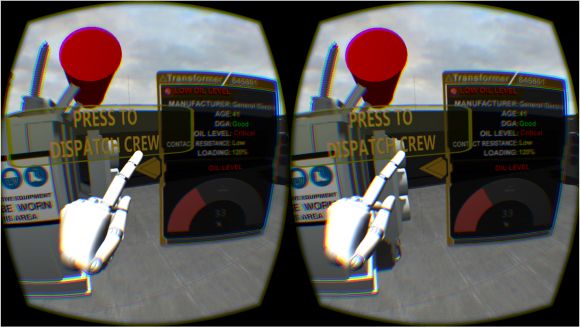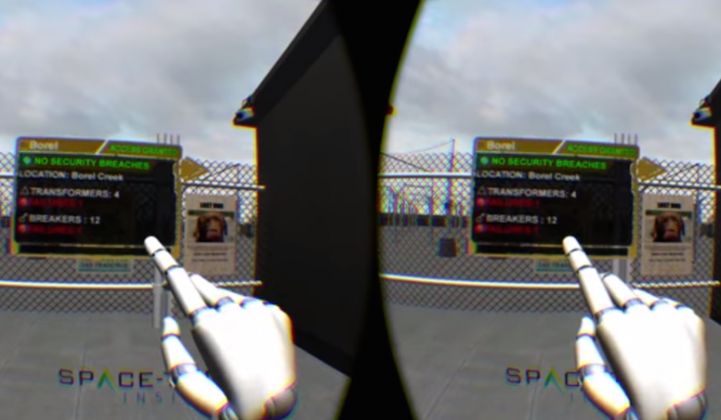Someday, utility workers may be able to don a Google Glass or Oculus headset to enter a world where power outages are pinpointed with flashing icons and leaking substation transformers can be tagged for repairs with the press of a virtual button.
Today, this vision may still be confined to demonstrations in conference rooms and trade show floors. But if utility software platforms and networked devices can populate these video-game-like interfaces with accurate and up-to-date data, they may be able to move from science fiction to practical use.
This possible future was on prominent display at last month’s DistribuTECH conference in San Diego, Calif., where several demonstrations were showing off the latest wearable computer-human interfaces and how they could be put to use for utility needs.
Take the demo put on by Space-Time Insight, featuring a set of Oculus Rift VR goggles and a three-dimensional model of a typical utility substation. About 250 people took a virtual tour of the substation, built with the same kind of data that the visualization and analytics software startup now collects for utility customers like Southern California Edison, San Diego Gas & Electric, and Hydro One, and is providing for new strategic investors E.ON and NEC.
Last week, I visited Space-Time Insight’s San Mateo, Calif. offices, put on the goggles, and went “inside the fence” of its virtual substation to see how it worked. First, I was directed to a circuit breaker where instruments had detected a leak of poisonous sulfur hexafluoride gas, which is invisible to the human eye but is represented by a cloud of green-colored steam in the virtual world.
Next up was a transformer with a dangerously low level of insulation oil, according to the utility’s asset management system -- again, not visible to the human eye, but colored red in Space-Time Insight’s visualization.
In both instances, the 3-D image of the troubled equipment was accompanied by a chart, suspended in midair, displaying all the data the utility would have to offer on the system, along with a “press to dispatch crew” button that I clicked with the finger of my VR-gloved hand.

None of Space-Time Insight’s utility customers are putting this kind of technology to real-world use yet, said Steve Ehrlich, the company’s senior VP of marketing and product management. But “to put this in a production environment, there’s no technical constraint,” he said.
Space-Time Insight is already pulling the same kinds of data that inform this virtual substation from customers like Hydro One and Sacramento Municipal Utility District to link asset management data, geographic information systems (GIS) data, and dozens of other existing utility data sources.
“Whether that’s being visualized in a screen or in this type of format, those are just alternative ways of visualizing the data,” he said. (Space-Time Insight calls this “situational intelligence,” and Ehrlich explained how the company's putting the concept to use for multiple utility needs at Greentech Media’s Soft Grid 2014 conference -- check out the video here.)
As for how this could be put to practical use, Ehrlich said the first benefit was to move beyond the charts and two-dimensional displays that now serve the purpose. The second was to provide the utility personnel at control centers the real-world view available to on-the-spot workers, and vice versa, so that each isn’t confined to radio or telephone conversations to explain what they’re seeing, he said.
Virtual reality could also be put to use in training new utility workers, particularly the younger ones who have grown up familiar with video games and other iterations of this kind of virtual environment. That’s an increasingly important issue for utilities facing the retirement of a significant number of experienced personnel in the coming years.
Of course, all of this depends on an accurate match between what’s really going on within each piece of equipment and its virtual representation. “It’s not just visualization -- there’s a ton of analysis that’s going on behind the scenes to present this,” said Ehrlich. While no amount of data can create a perfect digital representation, careful data science techniques can allow the system to know how confident it should be in what it’s rendering, he said.
While Space-Time Insight was showing off its fully virtual utility environment, another DistribuTECH demonstration was showing how data could be used to augment reality for similar uses. The utility-funded Electric Power Research Institute (EPRI) held a presentation to discuss how data could be integrated into wearable computer platforms, such as the XOEye, Google Glass, tethered GoPro camera, the Daqri helmet, and “skunkworks” wearables based on the Raspberry Pi platform, that it is testing or plans to test in the future.
EPRI’s February 2015 DistribuTECH briefing laid out how data from GIS and asset management systems could give field workers an augmented view of equipment that needs to be checked or repaired. Lots of companies are offering this kind of information to utility workers via hardened laptops, tablets or mobile devices, but bringing wearable computers into the mix could allow workers to view it in a “hands-free” manner -- something that’s particularly valuable when potentially dangerous repairs are going on.

Which option a utility will choose will depend on the total cost of ownership between a standard laptop or tablet device versus a wearable device, as well as how well prepared the utility is to support these devices with multiple integrated data streams, the briefing noted. To support that goal, EPRI is developing an “Open WMS” server that that can convert utility standards-based work order messages into data that can bring picture or video data to multiple platforms.
Google has already made the decision to stop selling Google Glass to consumers and repurpose it as a work tool for businesses, highlighting the fact that virtual and augmented realities like these need a practical, money-saving set of uses to justify their high costs.
We’ve reported on an early iteration developed to help solar panel installers with hands-free communication and data capture. Utility applications may not be far behind -- if the data that’s being provided them conforms to reality closely enough to turn them from eye-catching demonstrations to safe and effective tools.



